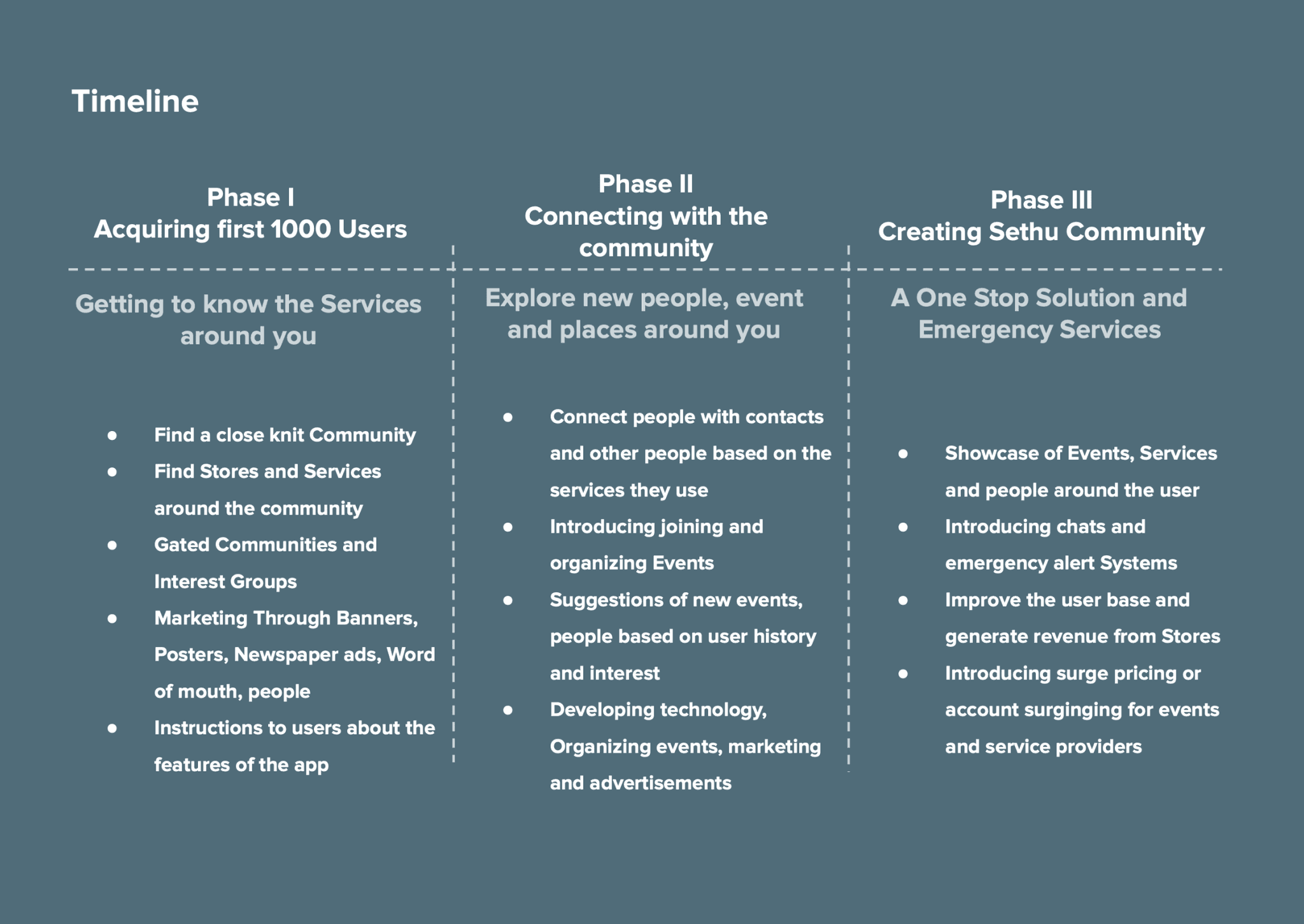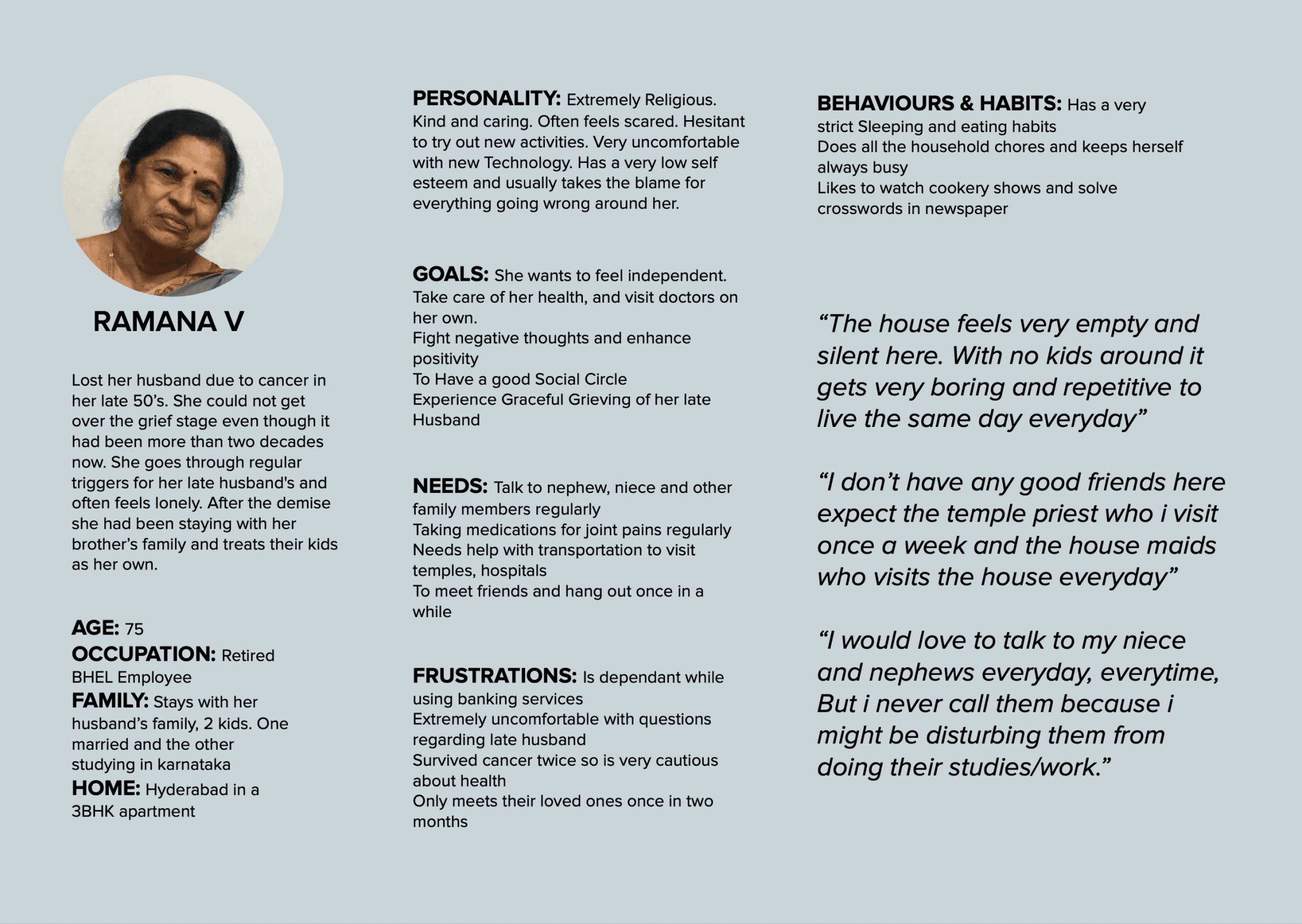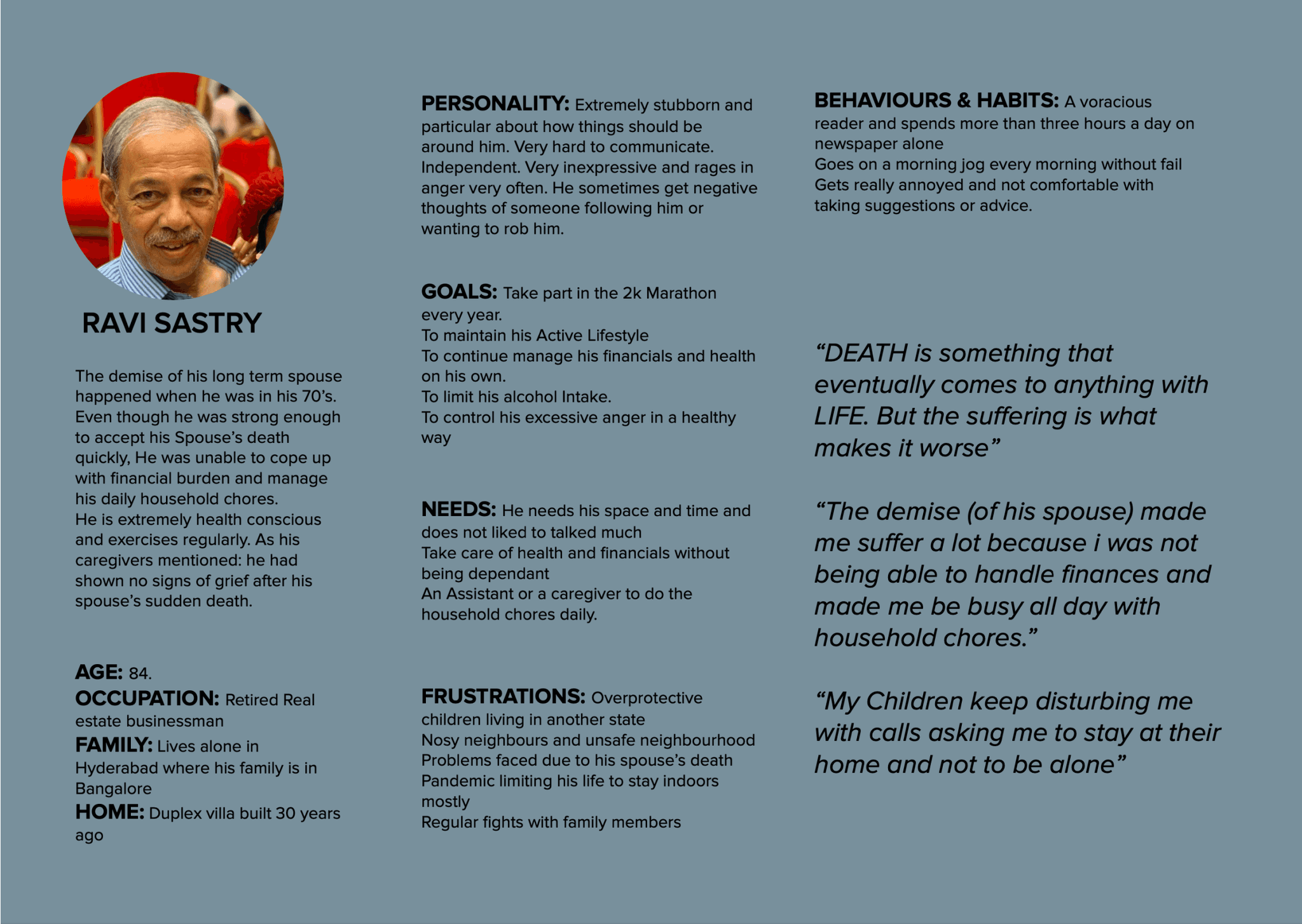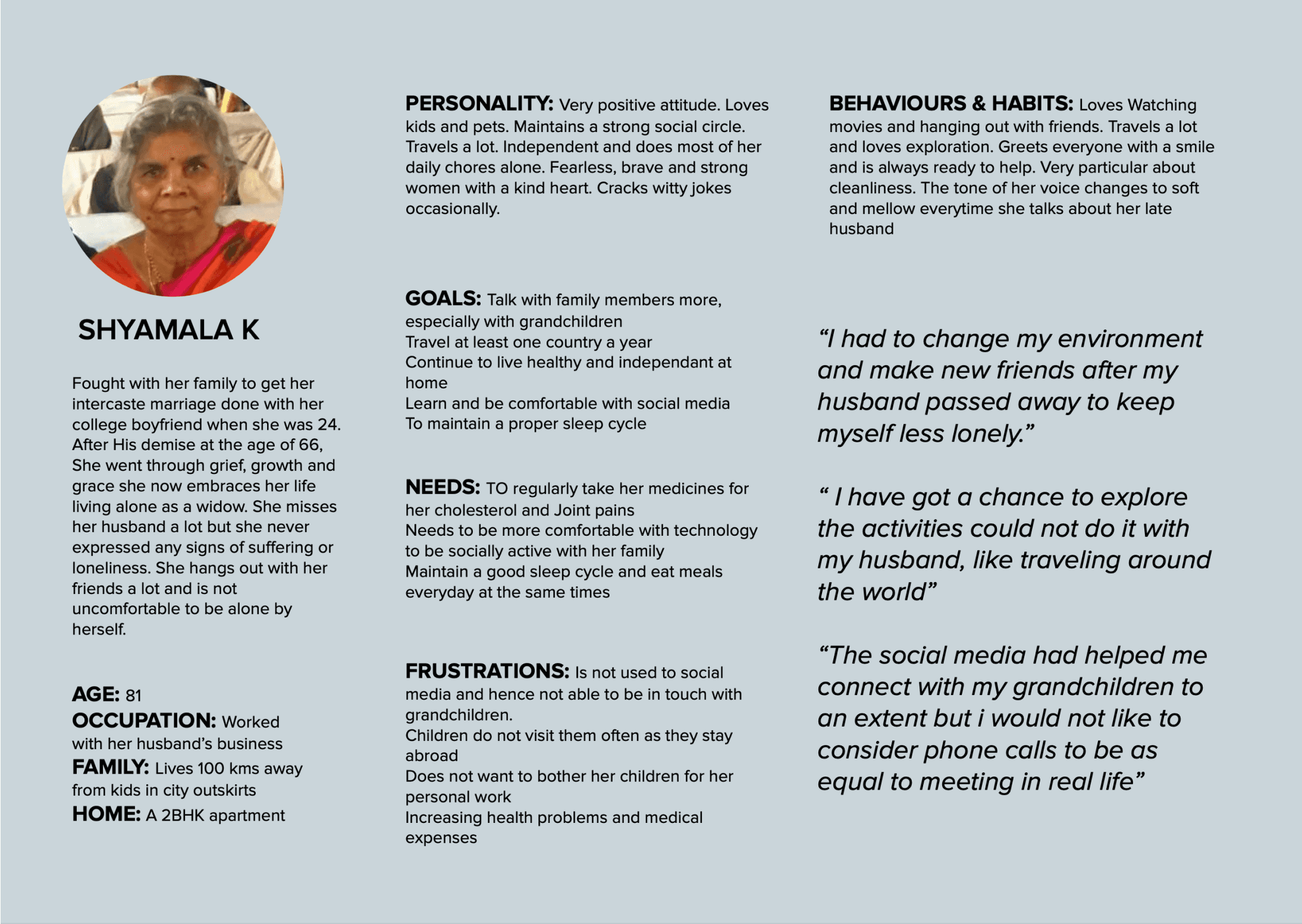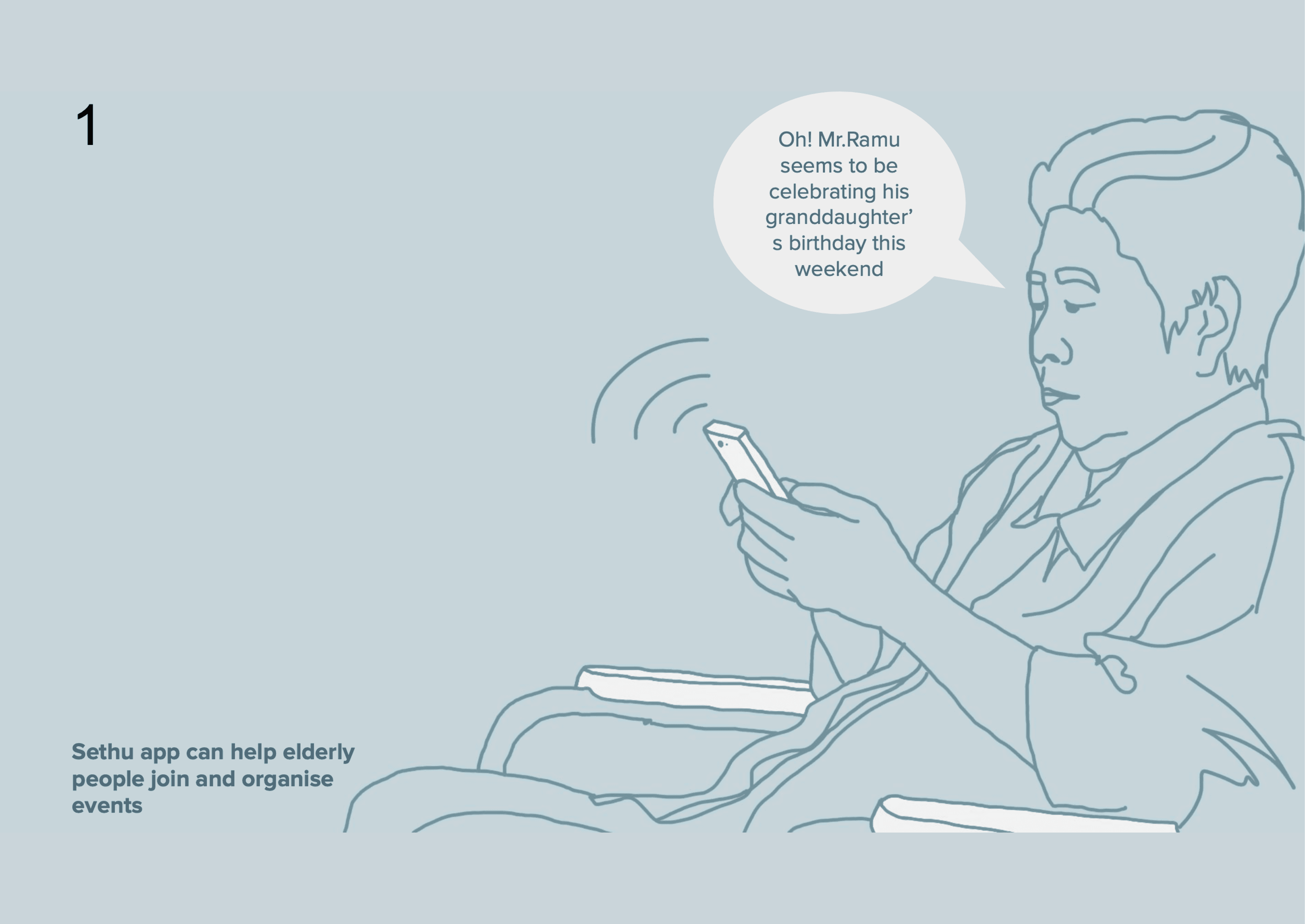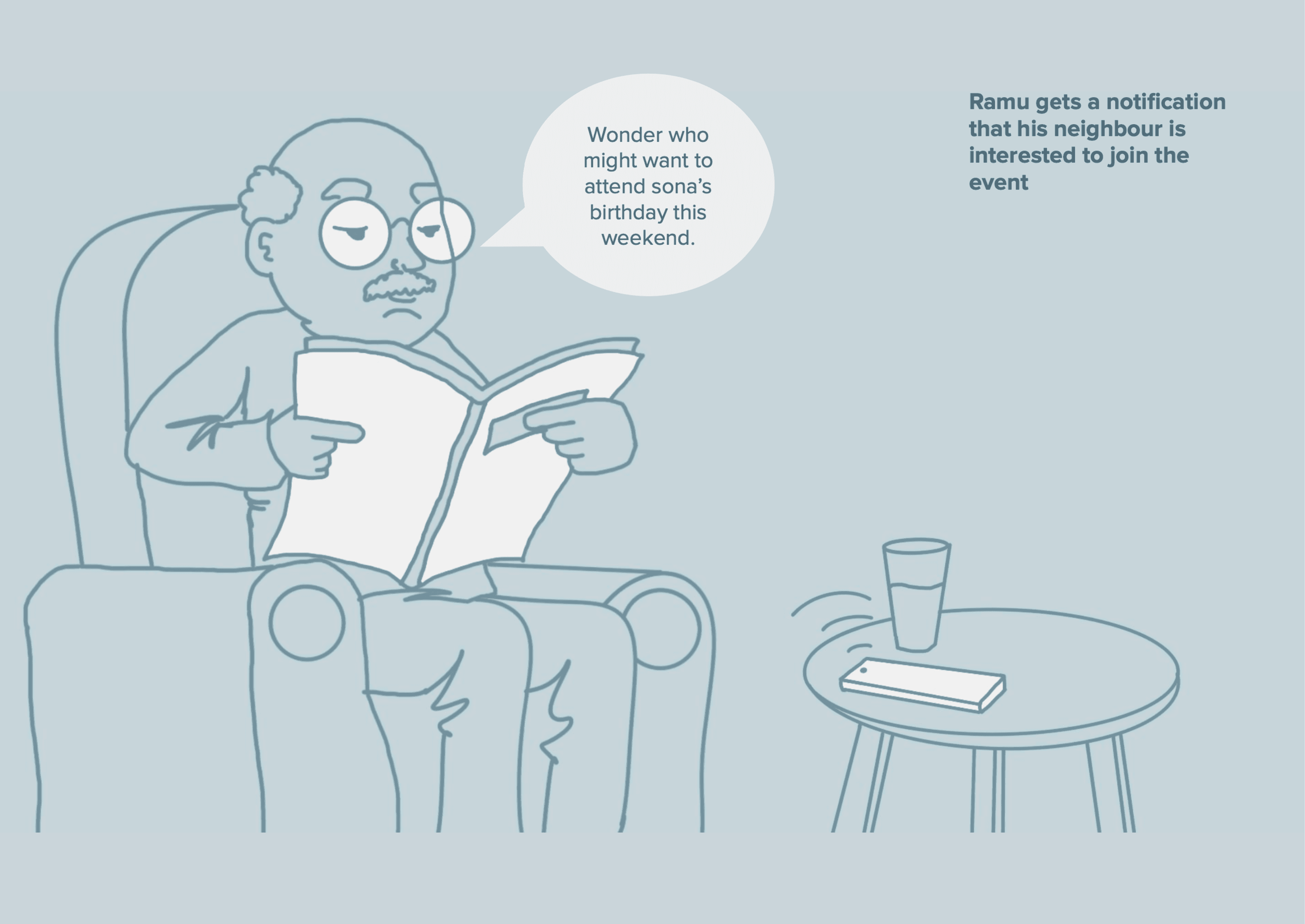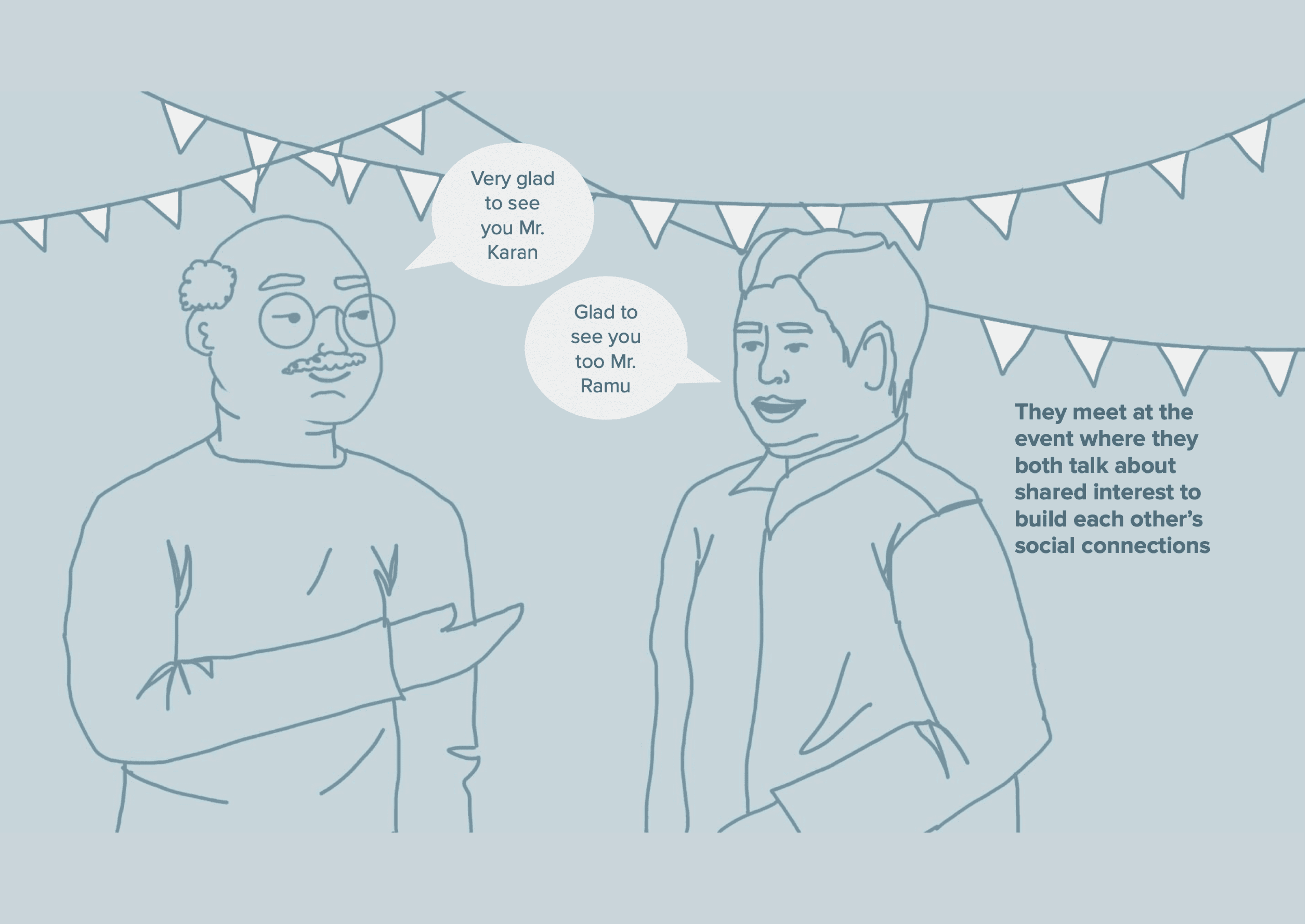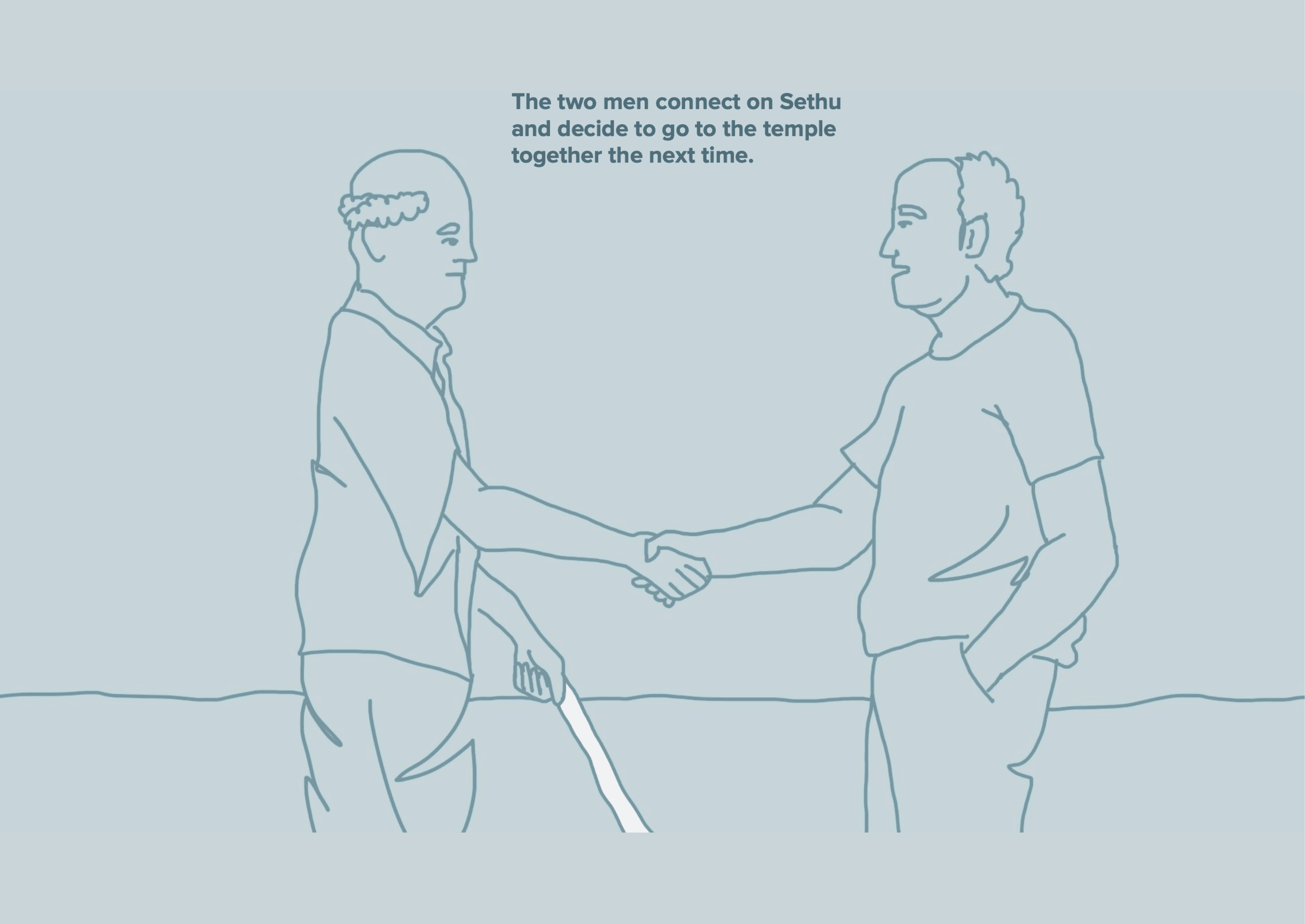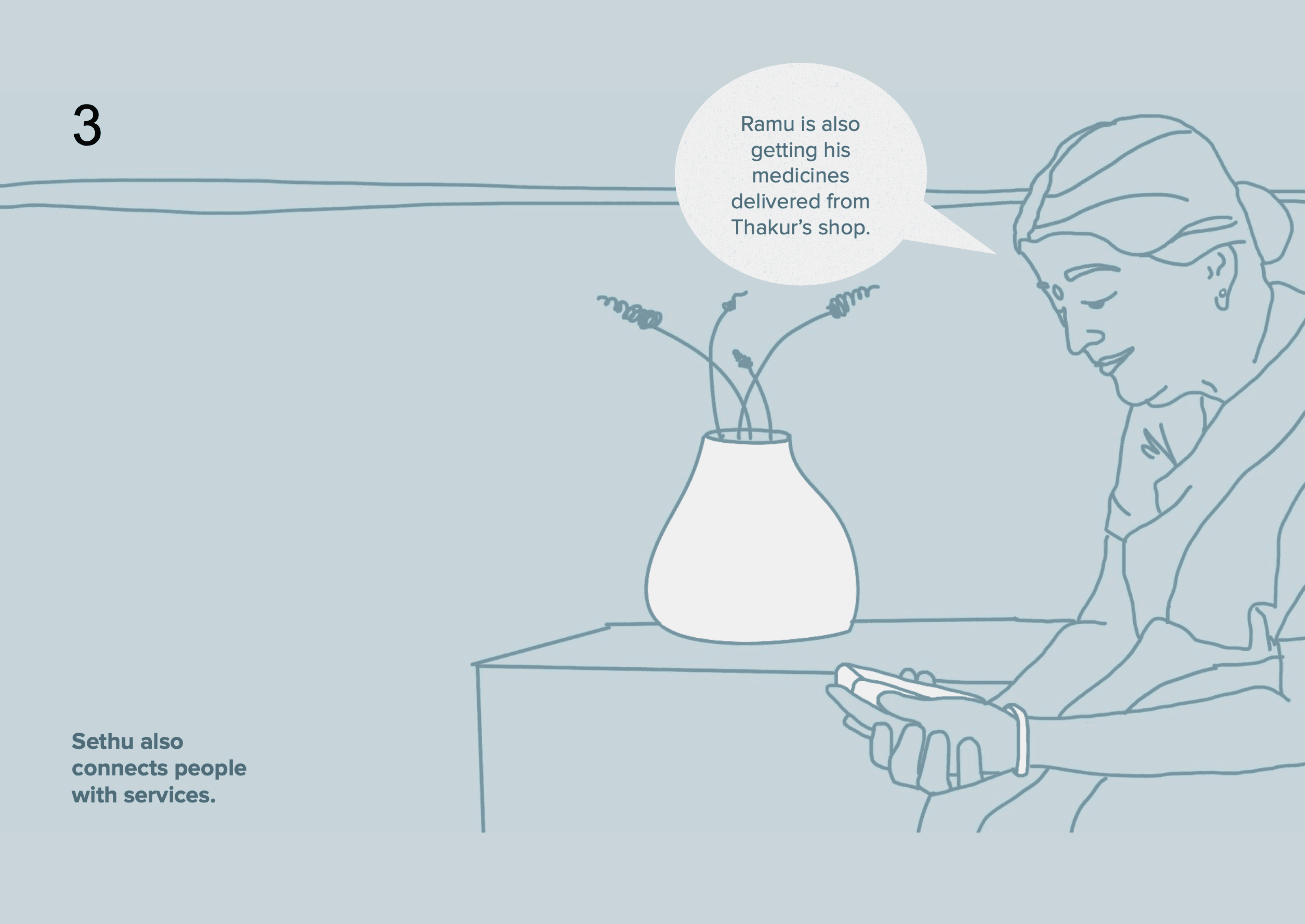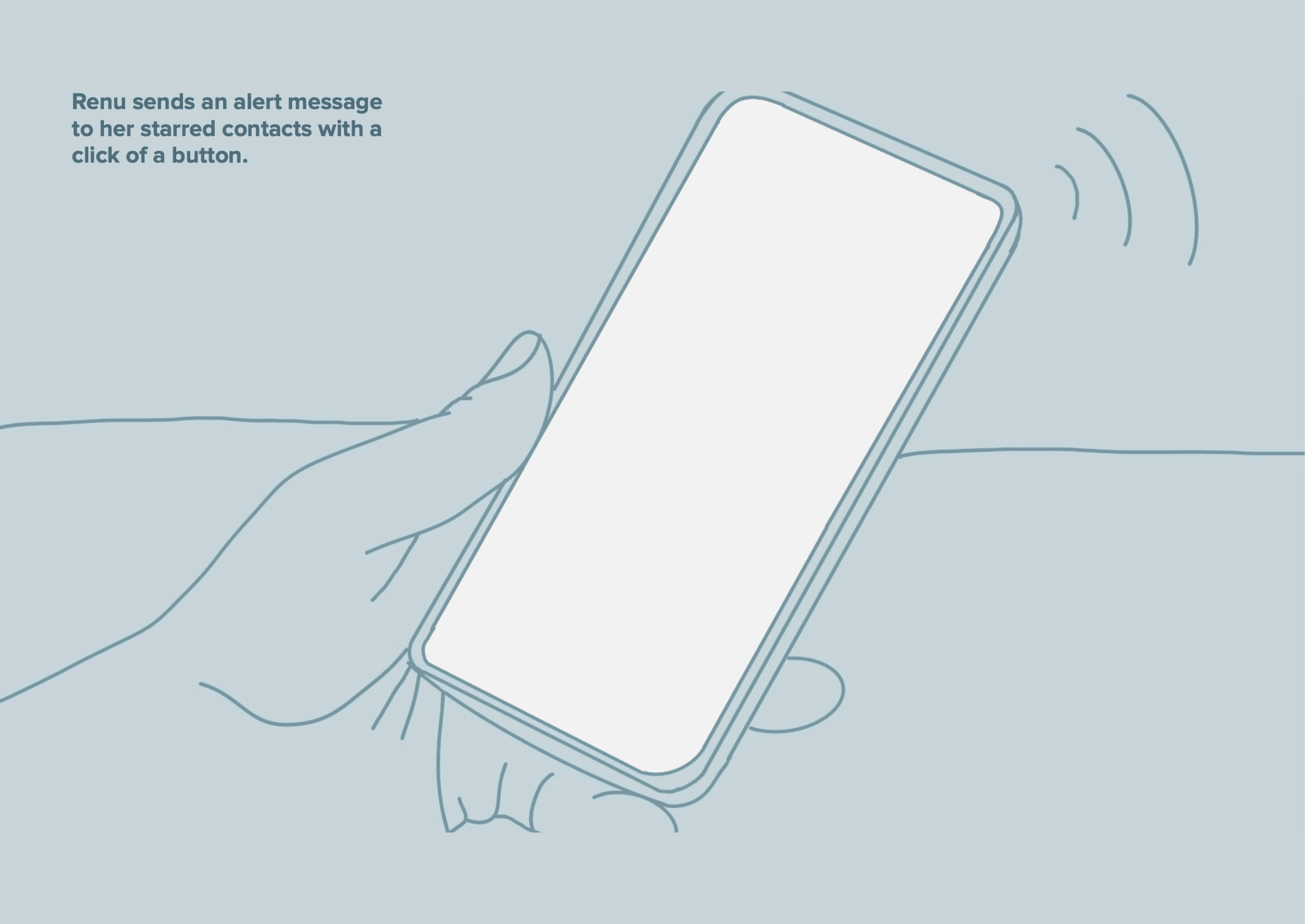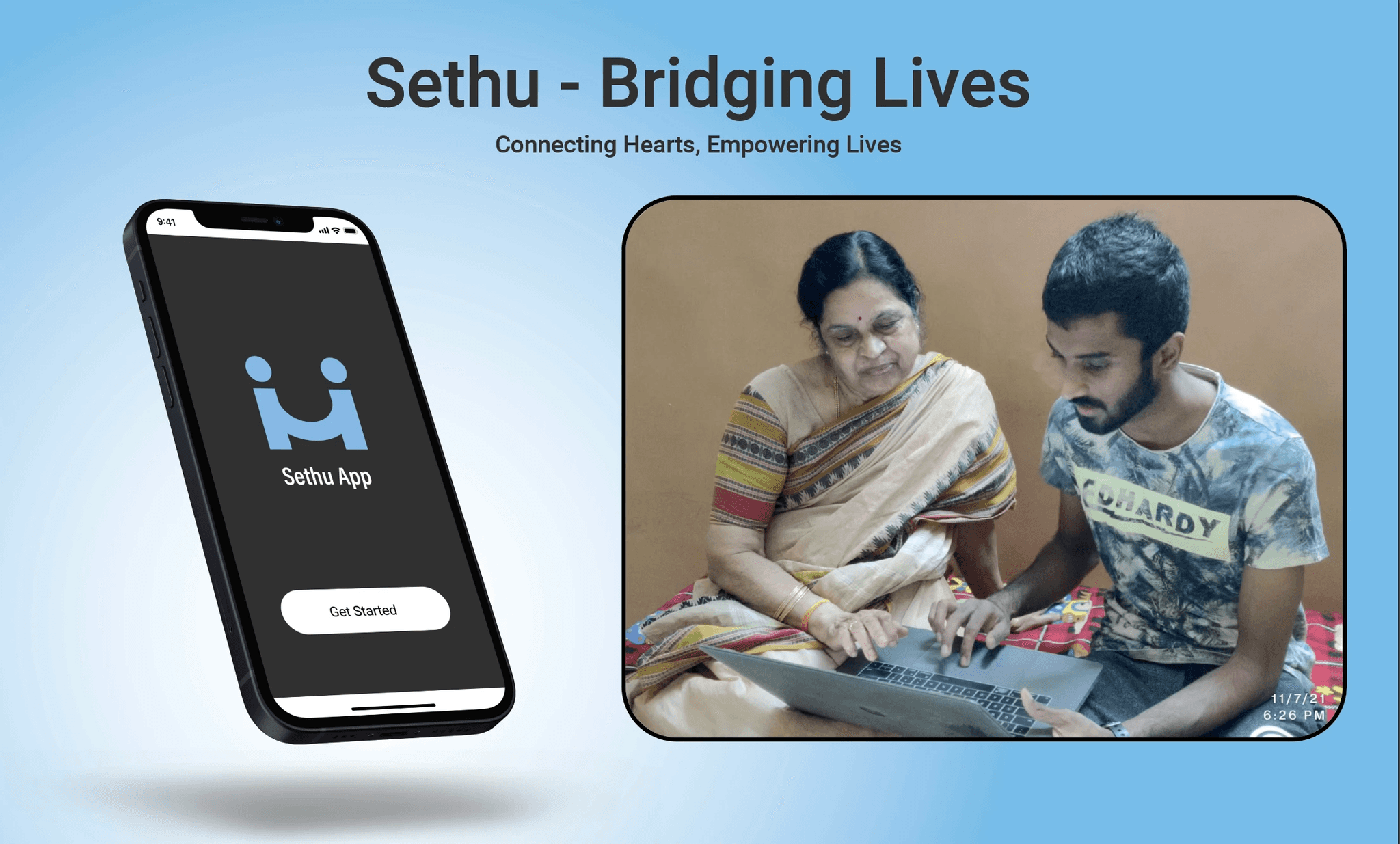
Sethu: Building Social Bridges for the Elderly
Connecting Hearts, Redefining Elderly Care.

8
Months
An undergraduate thesis project co-created with elderly individuals to address the widowhood effect and loneliness, focusing on empathetic design and promoting emotional well-being.
Summary:
Project Sethu is a service-oriented design initiative aimed at enhancing social connections for elderly individuals. The project addresses the problem of social isolation, which often leads to mental health issues like depression and loneliness in the elderly. Sethu provides a platform that integrates seamlessly into the daily lives of older adults, facilitating opportunistic social interactions and offering access to essential services. Whether it's connecting with friends, joining local events, or seeking help in emergencies, Sethu empowers the elderly to lead more socially fulfilling and connected lives. By addressing their unique needs, the project promotes better mental well-being and a sense of community, making it a crucial tool for elderly care, especially during times of isolation like the COVID-19 pandemic.

Emotional Journey Map of an elderly person during the first three months of widowhood
Process
Defining the Problem
The problem Project Sethu aims to solve is the social isolation and disconnection that many elderly individuals experience, leading to a decline in mental health. Elderly people often feel lonely and isolated due to diminished social networks, the loss of loved ones, or hesitation to initiate contact with family and friends for fear of being a burden. This isolation can lead to depression, anxiety, and a deterioration in their overall well-being.
Specifically, the challenge was:
"How might we design a service that fosters meaningful social connections for the elderly, enabling them to maintain and expand their social circles while ensuring their safety and access to necessary services?"
Elderly individuals need more opportunities for organic, day-to-day social interactions and a streamlined way to seek help when needed. Additionally, they require a system that fits into their daily lives without overwhelming them with complex technology.
Swipe to see more Personas, Hover to Pause.
Service Concept:
Project Sethu is a community-based digital platform designed to connect elderly individuals with their social circles, caregivers, and local services. The service focuses on integrating meaningful social interactions into the daily routines of elderly users, providing them with a safe and simple interface that encourages:
Opportunistic Social Interactions:
Sethu helps elderly users connect with others in their vicinity, whether for casual social events, volunteer-led activities, or professional support. Users can find new friends, connect with family members, or join local events relevant to their interests.
Access to Essential Services:
Sethu is a one-stop platform where elderly individuals can easily access essential services like medical resources, grocery deliveries, and tiffin services. These are provided within a local radius to ensure the services are timely and relevant.
Emergency Support:
The app allows users to star trusted contacts who can be alerted immediately in case of emergencies, providing a sense of security.
By integrating these key elements, Sethu provides a well-rounded solution that not only tackles loneliness but also enables elderly individuals to remain connected and cared for within their communities.
Research
Process
To design a service that effectively addresses the social isolation of the elderly, a comprehensive research process was initiated. The aim was to deeply understand the social dynamics, emotional needs, and daily routines of elderly individuals to create a solution that fits seamlessly into their lives.
What Was Done:
Stakeholder Mapping:
The research started by identifying key stakeholders who play an essential role in the lives of elderly individuals. This included not only the elderly themselves but also caregivers, family members, volunteers, healthcare providers, and service professionals. The stakeholder map helped visualize the various connections and interactions that exist around the elderly and where potential gaps in social support may lie.
Primary Research (Interviews & Diary Studies):
To gather real-life insights, interviews were conducted with a diverse group of elderly participants, including caregivers, widows, elderly couples, and ex-caregivers. This primary research aimed to capture their feelings of isolation, how they currently manage social interactions, and what they need to feel more connected. Additionally, diary studies were used, where participants recorded their thoughts, routines, and interactions over a period of time. This provided a detailed look into the daily lives of elderly individuals and the moments of social disconnect they experience.
Cultural Probes:
Cultural probes, such as small activities, question cards, and visual prompts, were provided to participants to explore their thoughts about social connections in creative ways. These helped uncover deeper emotional and social needs by prompting participants to think about their relationships, social routines, and barriers to interaction.
Co-Creation Workshops:
Elderly users participated in hands-on co-creation workshops where they helped design and refine the service concept. Through tools like visual storyboards and scenario-building, the workshops enabled participants to envision how Sethu could be integrated into their lives. They were encouraged to comment on the design, identify areas of improvement, and suggest features that would make the service more relevant and accessible to them.
Personas & Emotional Journey Maps:
From the interviews and diary studies, personas were created to represent typical elderly users, including their social habits, emotional struggles, and technological abilities. Emotional journey maps were developed to illustrate the highs and lows in their daily interactions, highlighting key points where social interventions could make a positive impact.
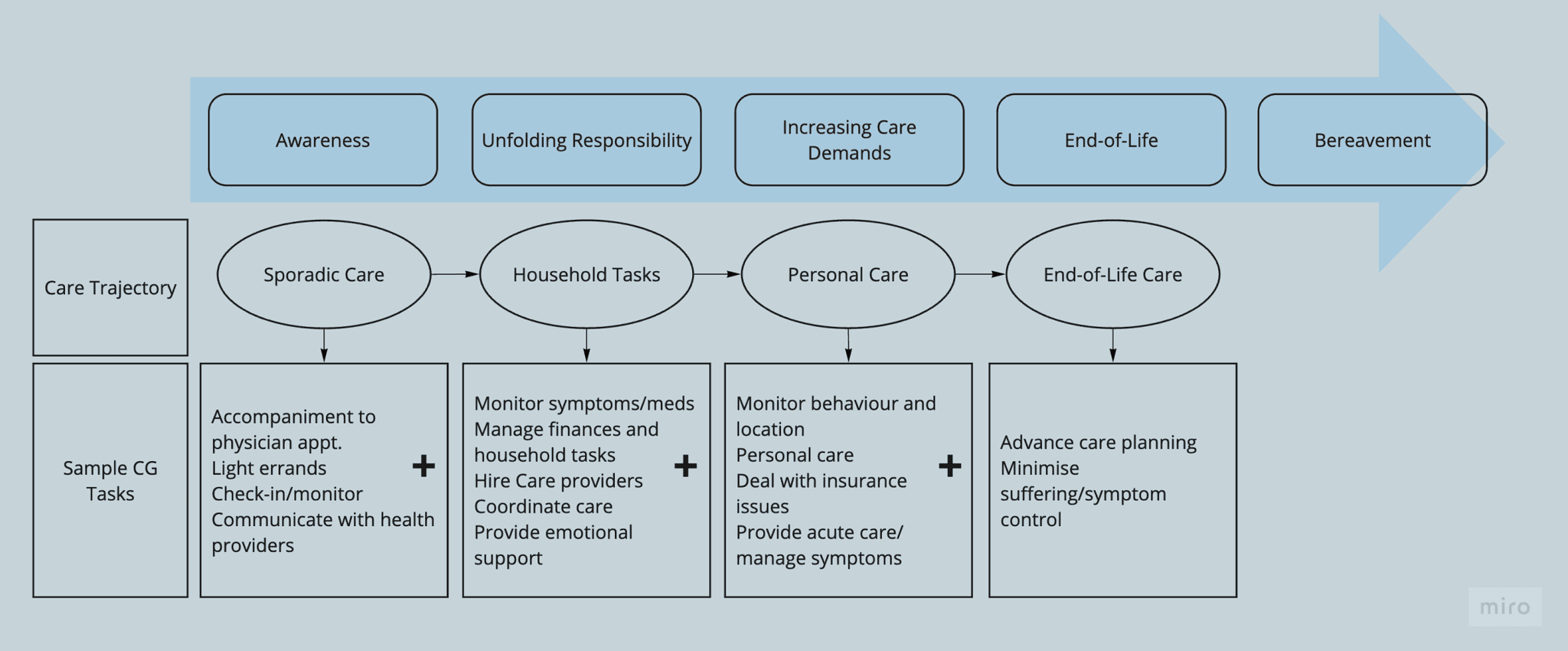
Phases of the caregiver’s role
Research Goals:
Emotional Needs: How do elderly individuals feel about their current social interactions? What are the emotional consequences of their isolation?
Social Barriers: What prevents them from initiating contact or building social connections? Is it a fear of being a burden, a lack of confidence, or something else?
Technology Gaps: What kind of technology do they currently use, and how comfortable are they with digital tools? How can a service like Sethu be made accessible and user-friendly for them?
Safety & Security Concerns: What are their concerns about privacy and security when it comes to using technology for social connections?
Research
Tools and Methodologies Used
Exponential Snowball Sampling:
This sampling method was used to identify participants by having existing participants refer others who may be in similar situations (e.g., elderly individuals with different backgrounds). This helped create a diverse participant pool while maintaining relevance to the study’s objectives.
Interviews and Cultural Probes:
In-depth interviews and cultural probes allowed for the collection of qualitative data on the emotional and social experiences of the elderly. This was crucial for understanding the context of social isolation.
Diary Studies:
By having participants document their daily routines, a deeper understanding of their social interactions, habits, and the gaps in their social lives was obtained. This method highlighted when and where elderly people felt most isolated.
Co-Creation Workshops:
These workshops were a key methodology, as they directly involved elderly participants in the design process. Visual tools like storyboards and scenario-building exercises allowed participants to actively shape the service concept, ensuring that the design aligned with their real needs.
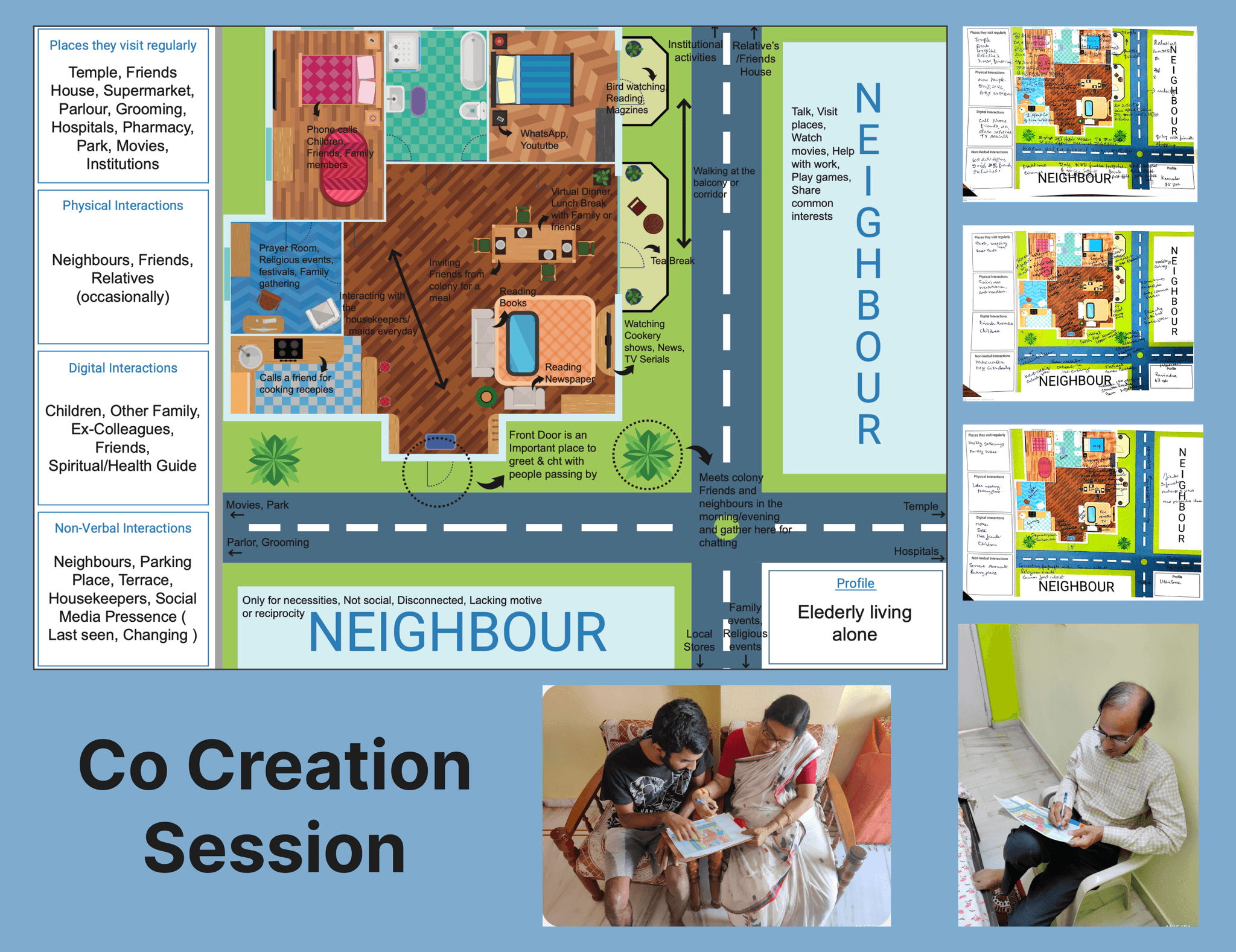
Elderly participants engaging in co-creation workshops
Research
Key Findings
The research uncovered several critical insights into the social dynamics and emotional needs of elderly individuals, as well as the challenges they face when trying to stay connected with their social environment. These findings shaped the development of Project Sethu and informed the design decisions that followed.
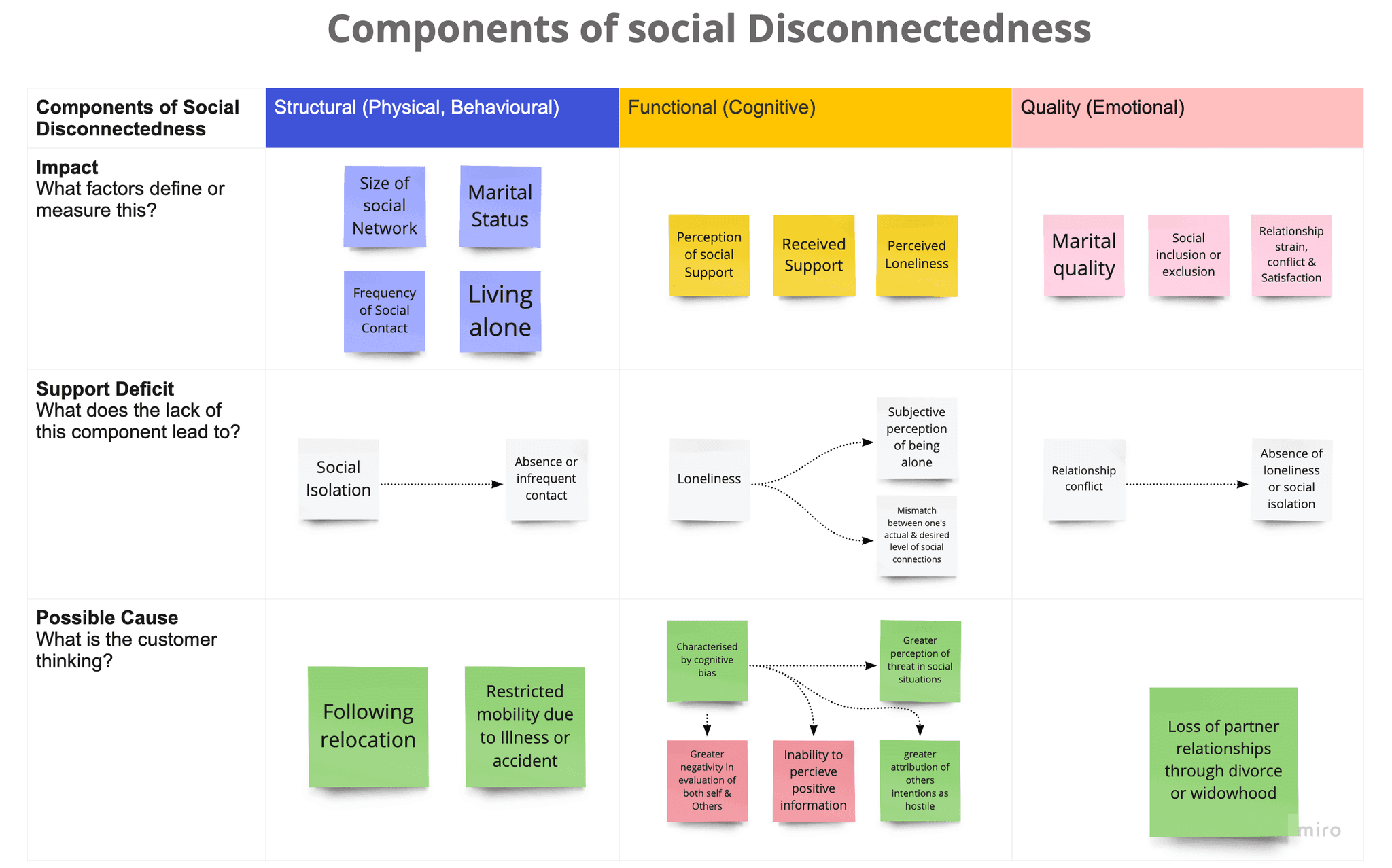
Understanding social disconnectedness
Fear of Being a Burden:
A significant number of elderly participants expressed reluctance to initiate contact with family and friends. Many feared they might interrupt their loved ones' busy schedules, particularly when it came to younger family members. This led to a deeper sense of isolation, as they preferred to remain silent rather than reach out, even though they craved social interaction.
Desire for In-Person Interaction Over Digital Communication:
Although technology like social media and phone calls helped some elderly participants stay in touch with family, they emphasized that these forms of communication are not substitutes for in-person interaction. Real-life meetings were seen as more meaningful, with participants longing for more face-to-face conversations and physical presence, which they felt digital communication couldn’t replicate.
Technological Barriers and Limited Digital Literacy::
Many elderly users found modern technology overwhelming, particularly interest-based mobile apps or complex social media platforms. While they were open to using technology, they needed interfaces that were simple, intuitive, and specifically tailored to their needs. This highlighted the importance of creating a user-friendly design with clear, minimal steps to avoid confusion.
Social Isolation Amplified by Physical Limitations:
Several participants noted that their physical limitations, such as mobility issues or health problems, further restricted their ability to engage in social activities. For some, even small outings felt like significant hurdles, increasing their dependency on others for both social interactions and access to essential services.
Privacy and Security Concerns:
Privacy was a major concern for elderly participants when using digital platforms. They worried about sharing too much information online and about the possibility of scams or data misuse. Any solution, therefore, needed to address their need for secure, trustworthy systems that respect their privacy.
Importance of Routine and Familiarity:
Elderly participants valued services and technologies that fit seamlessly into their daily routines. Any disruption to their regular activities was seen as a barrier to adoption. Therefore, it was essential for Project Sethu to complement, rather than complicate, their existing routines.
Community Engagement and Support Networks:
The research revealed that elderly individuals who remained connected to local communities—through religious gatherings, local events, or neighborhood groups—reported higher levels of emotional well-being. They found a sense of comfort in smaller, localized networks rather than broad, anonymous digital platforms.
Iterations
Refining Sethu
The development of the design solution for Project Sethu was a highly iterative process that evolved based on continuous user feedback, co-creation sessions, and usability testing. The goal was to ensure that the final product was not only functional but also deeply aligned with the real needs and behaviors of elderly users. Each iteration focused on refining the user experience, simplifying the interface, and addressing specific concerns raised during research.
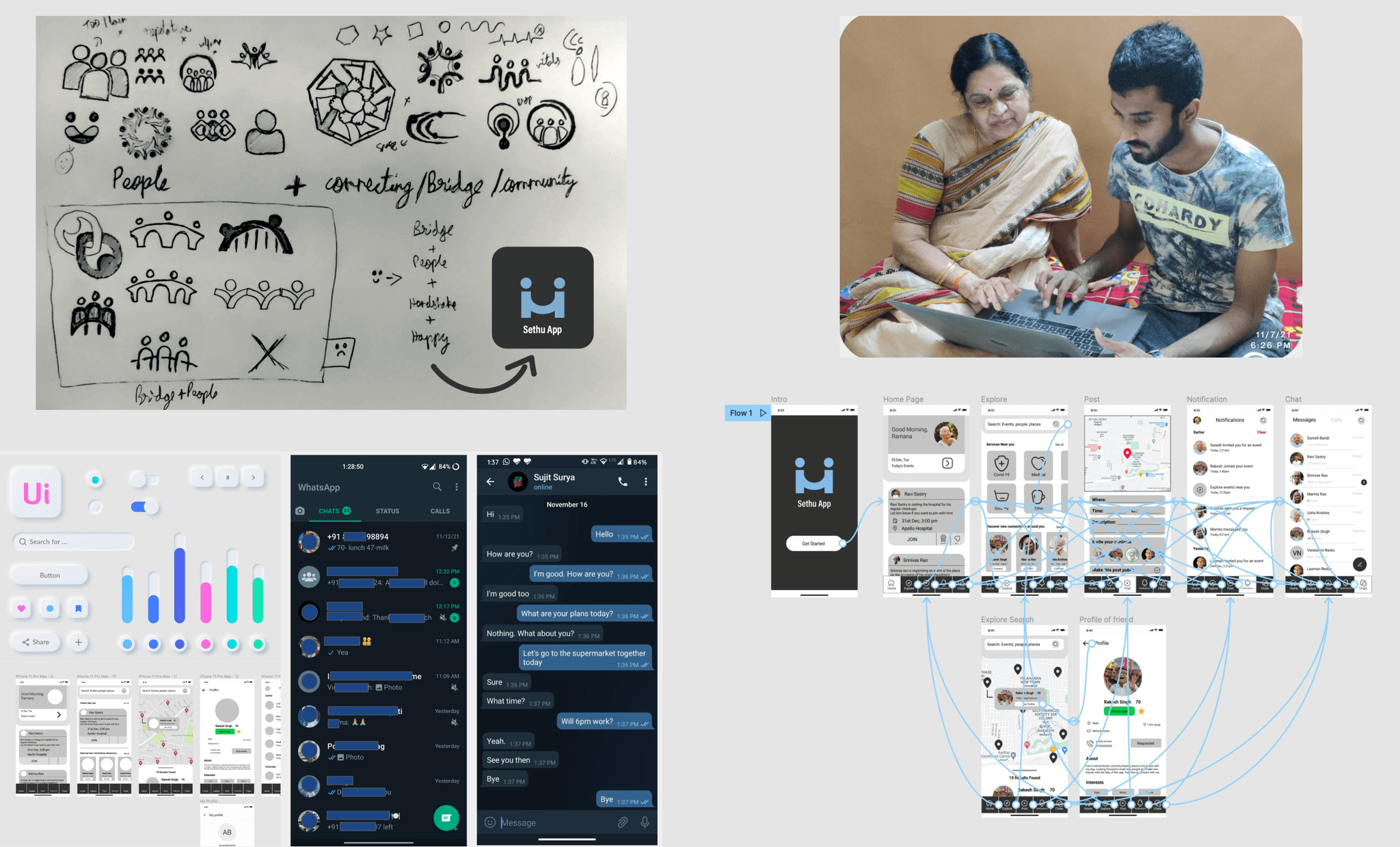
Evolution of design images showing wireframes from different stages of the design process. User input directly influenced the changes in the interface, particularly around simplifying workflows or emphasizing emergency features.
Initial Concept Development:
The initial concept for Project Sethu was to create a platform that combined social interactions with essential services in one place. Early wireframes included a robust interface that allowed users to:
Connect with friends and family
Join local events
Access services like medical resources and daily essentials
Receive emergency support by connecting to trusted contacts
Early Feedback: Users appreciated the concept of a one-stop platform but found the early design overwhelming. The elderly participants, in particular, struggled with the complexity of navigation, which included too many features and options on each screen.
Simplifying the Interface:
In response to user feedback, the next iteration focused on simplifying the user interface (UI). The design team reduced the number of visible features on each screen and introduced larger, clearer icons and buttons to make navigation easier. The layout was streamlined, ensuring that users could access core functions such as social interactions and emergency contacts without having to navigate through complex menus.
Key Changes:
Consolidation of Features: Some features were combined into broader categories. For instance, the "Explore" section was designed to house local events and essential services, reducing clutter and confusion.
Larger Icons & Font Sizes: To improve accessibility, the design adopted larger icons and fonts, making it more readable for elderly users with vision difficulties.
Co-Creation Input:
As the co-creation process continued, elderly participants were invited to assemble the interface components themselves, choosing which features they wanted more prominently displayed. This led to critical insights about how elderly users prioritized different functions of the app. For example, emergency contacts were moved to the forefront based on user preference, allowing for immediate access in case of a crisis.
Key Adjustments:
Prioritization of Emergency Features: Participants wanted quick access to emergency alerts, so this feature was made central, appearing on the home page and requiring minimal steps to activate.
Customization Options: The ability for users to "star" key contacts (for emergency alerts) and mark important events or services was added, allowing for a more personalized experience.
Streamlining User Workflows:
The next iteration focused on streamlining the workflows for each key function in the app, ensuring that users could complete tasks with fewer steps. For instance:
Creating a Post or Event: Initially, creating a new post or event was a multi-step process with several screens. This was simplified to allow users to quickly invite their connections or mark an event with just two or three actions.
Navigating Services: The service section was refined to include only the most relevant categories for elderly users, such as medical services, food delivery, and community volunteering.
Usability Testing Feedback: Participants found the workflows to be much smoother and reported feeling less frustrated with the app’s navigation. They appreciated the reduction in the number of steps needed to complete a task.
Ensuring Privacy & Security:
During the iterations, it became clear that privacy and security were top concerns for elderly users. They were worried about their data being misused or their information being accessible to strangers. To address this:
Privacy Settings: A privacy control panel was added, allowing users to manage who could see their information and posts.
Emergency Contact Safeguards: Users could now designate a set of trusted contacts who would be alerted in emergencies, ensuring that the system did not inadvertently notify the wrong individuals.
Final Iteration and User Feedback:
In the final iteration, the app was tested again with elderly participants, focusing on usability, functionality, and emotional resonance. This version incorporated:
A highly intuitive interface with large buttons and easy-to-follow navigation.
Emergency alerts at the forefront of the design for quick access.
A community-centric design, emphasizing local connections and events.
Customizable notifications that allowed users to stay updated without being overwhelmed by information.
Final feedback indicated a high level of satisfaction, with users reporting that the platform felt tailored to their needs, both in terms of simplicity and functionality.
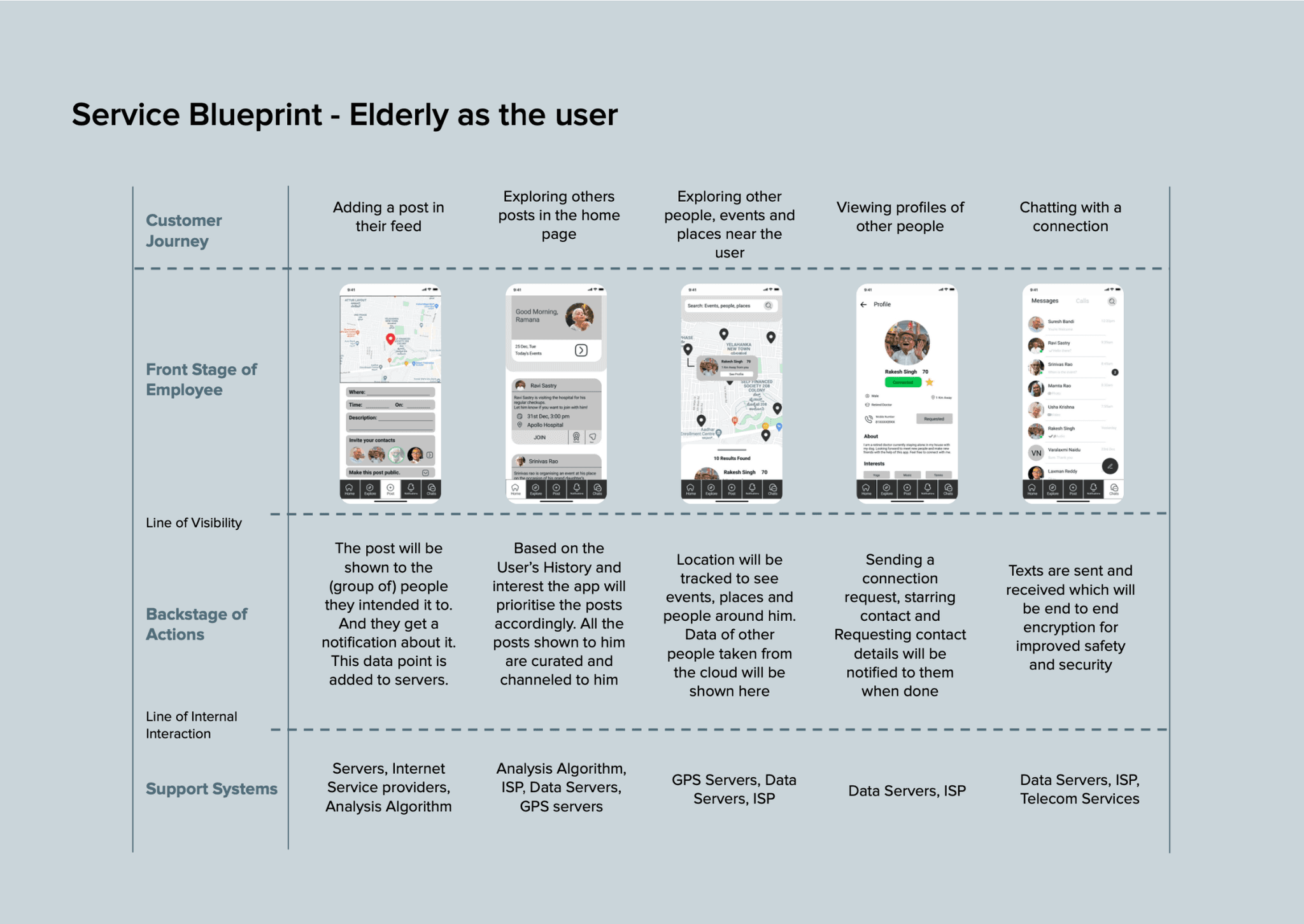
Design Solution
Sethu: Building Social Bridges for the Elderly
The design solution for Project Sethu revolves around creating a simple, intuitive platform that meets the social and emotional needs of elderly individuals while providing essential services and emergency support. The final design emphasizes ease of use, security, and fostering meaningful connections through a well-structured, user-friendly app interface.
These are the storyboards depicting four scenarios that illustrate how elderly users interact with the Sethu platform, from connecting with friends and joining events to accessing essential services and triggering emergency alerts.
Swipe to see more, Hover to Pause.
Key Components of the Design Solution:
Home Page – Central Hub for Social Connection:
The home page serves as a dashboard where elderly users can view events organized by friends, their bookmarked activities, and recent updates. It is the entry point for accessing everything they need, structured to feel familiar and easy to navigate. Users can quickly check notifications, social updates, and upcoming activities without having to search through multiple menus.
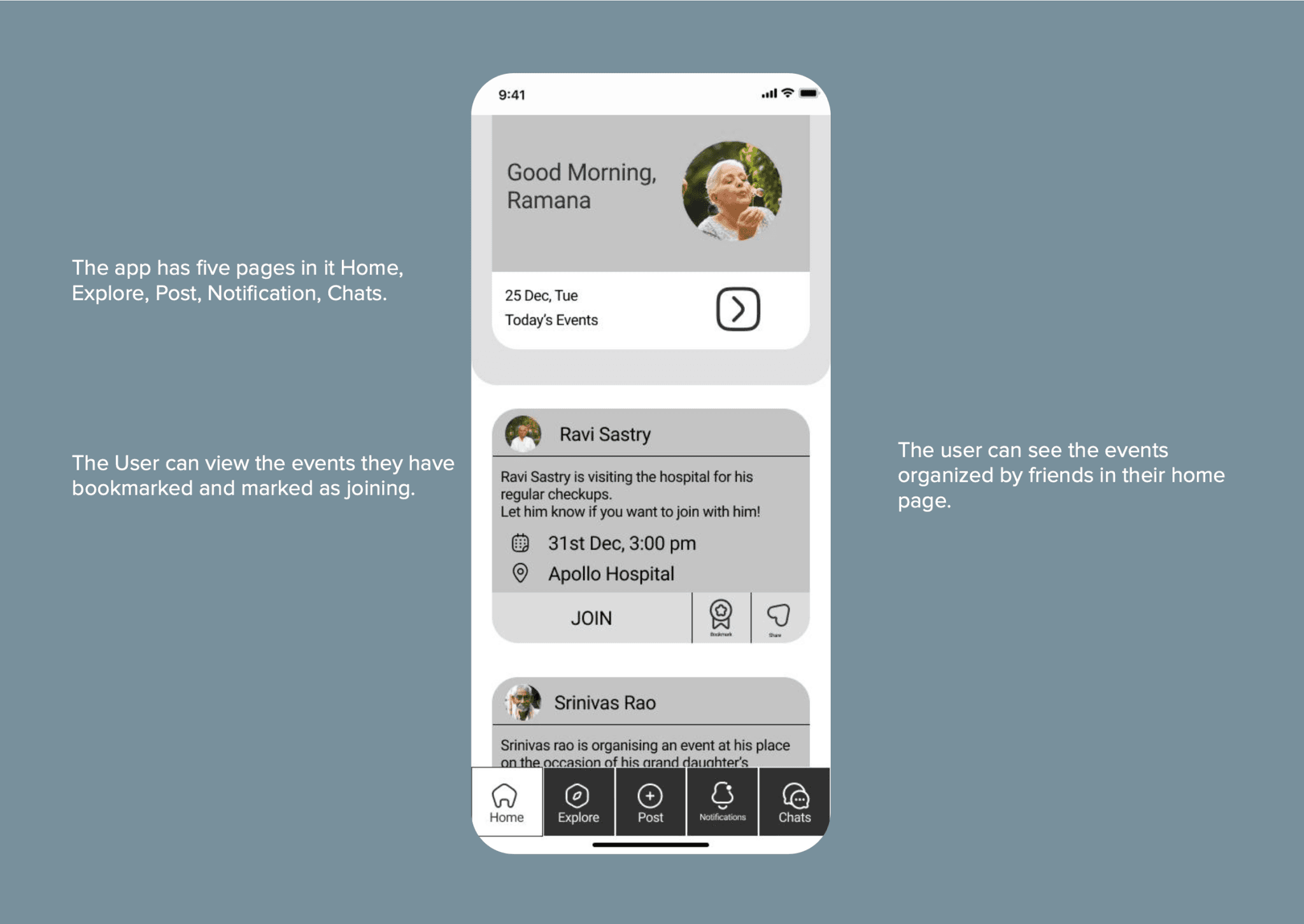
Explore Section – Discover Events, Services, and Connections:
This section is designed to enable users to explore services and events within their locality.
Users can:
Find Local Events: Based on their interests and activity history, users can discover nearby events, whether they are community gatherings, hobby-based meetups, or support groups.
Access Essential Services: This includes medical facilities, grocery delivery, and tiffin services. Services are presented in an easily accessible format, allowing elderly users to find and contact them without technical difficulty.
Meet New People: Users can explore connections with other elderly individuals in their area, volunteers, or professionals offering caregiving or other support services.
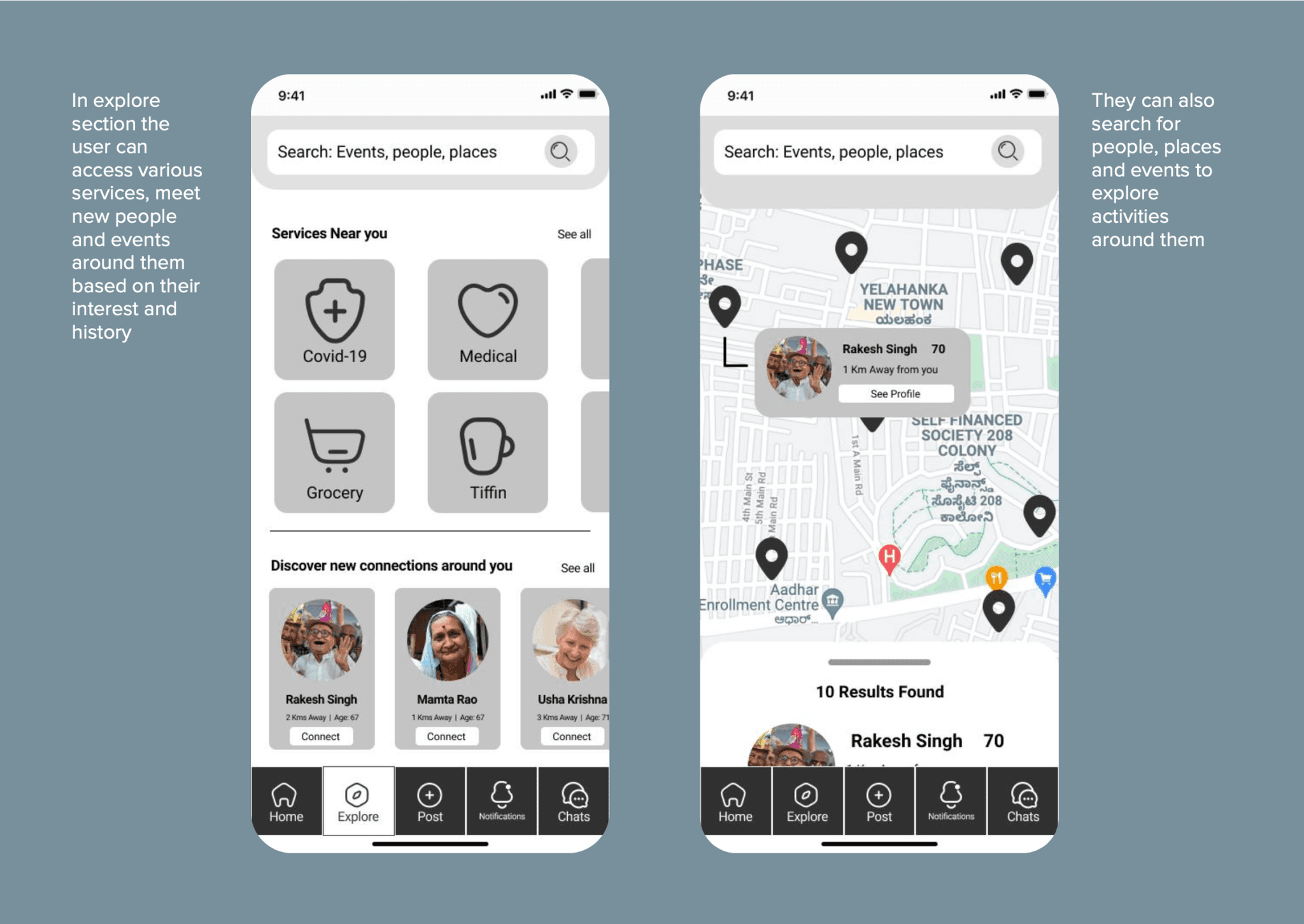
Post Creation – Share Updates or Organize Events:
Elderly users can create posts that are either private (shared with selected contacts) or public (open to a broader audience). This allows them to invite others to participate in activities or share updates with their community in a simple, secure way. Posts could range from personal updates to invitations to events.
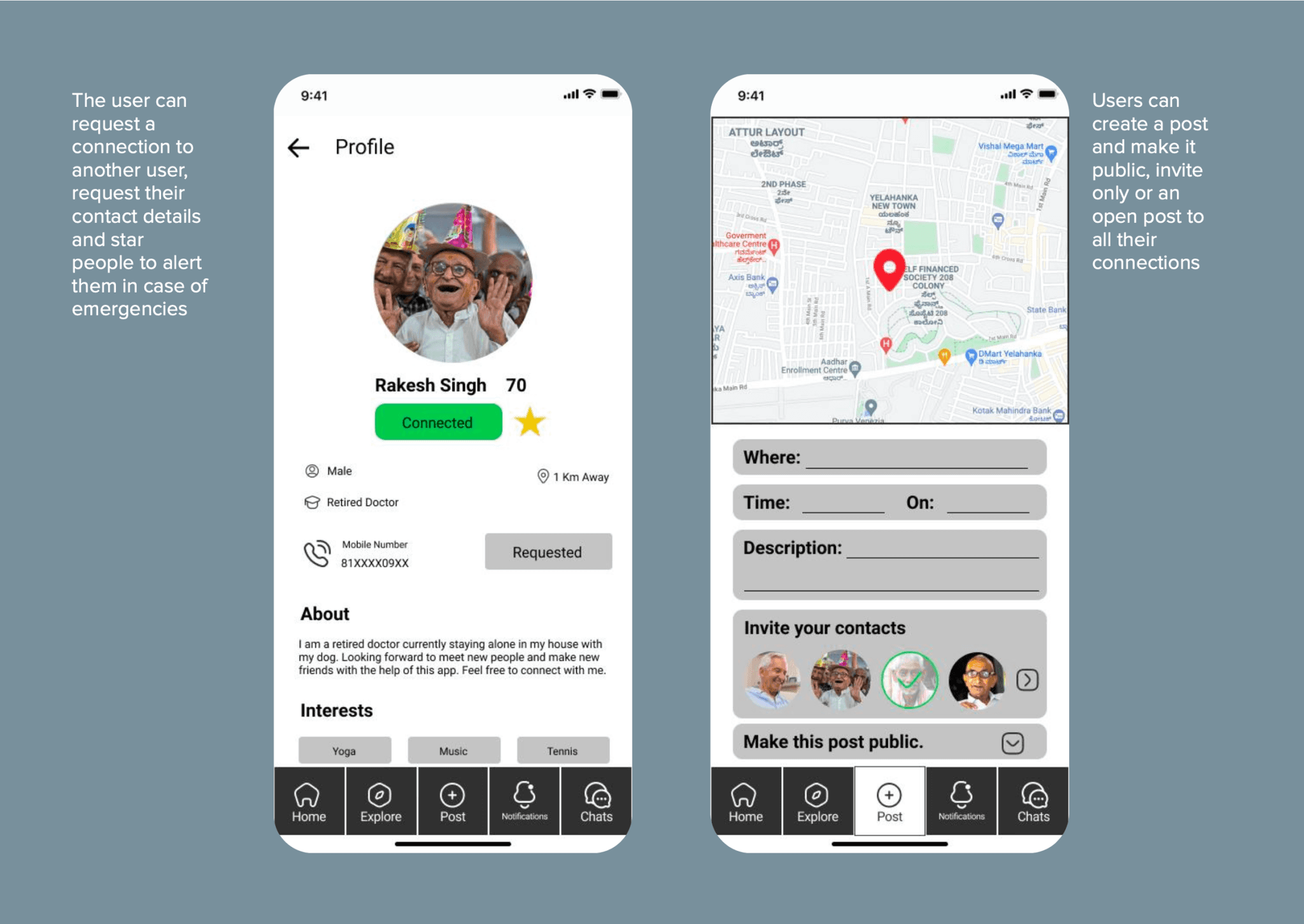
Chats – Simple, Streamlined Communication:
The chat feature enables users to easily communicate with their connections, whether they are friends, family members, or volunteers. The interface is designed to be clutter-free, mimicking familiar messaging applications, but with larger fonts and fewer distractions to make communication effortless.
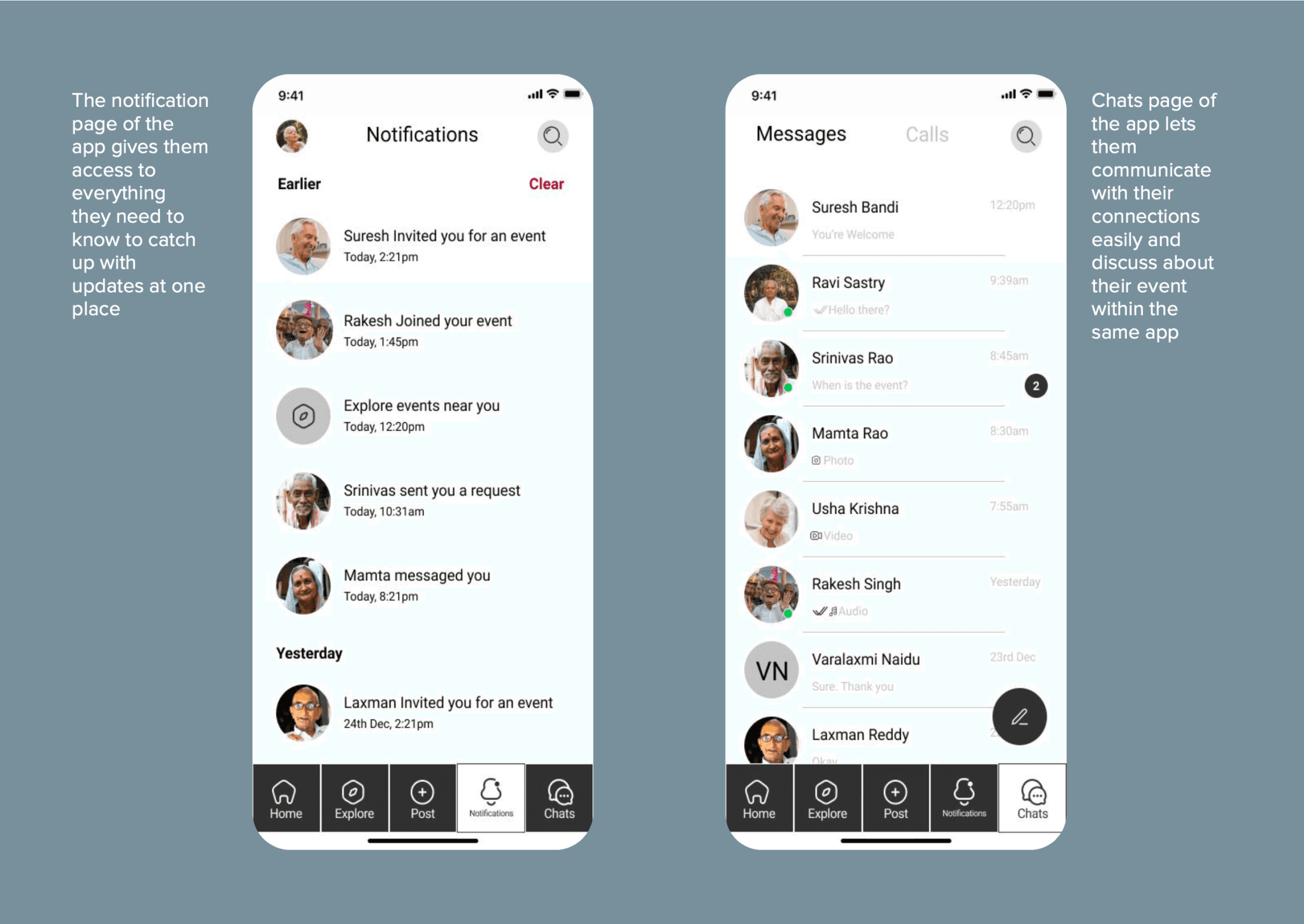
Emergency Alert System – Immediate Assistance:
One of the most critical features of the app is its emergency alert system, which allows users to quickly notify a selected group of trusted contacts in case of an emergency. This system is accessible directly from the home page with minimal navigation required, ensuring users can request help with just a few taps.
Starred Contacts: Users can mark certain people as emergency contacts, who will be immediately notified if an alert is triggered.
Custom Alerts: Depending on the type of emergency (medical, emotional, etc.), users can customize the alert and the message sent to contacts.
Notifications – Stay Updated with Important Information:
The notification page consolidates all the key updates in one place. This includes reminders about upcoming events, updates from friends, and notifications from local services. The notification system is designed to keep users informed without overwhelming them, with an option to turn off unnecessary alerts.
Privacy and Security – Safe Social Engagement:
Privacy was a top priority in the design solution. The app includes robust privacy settings that allow users to control who can see their posts, events, or personal information. The design ensures that elderly users feel secure sharing their information and interacting within the platform, with clear options for reporting any issues or concerns about privacy breaches.
How the Solution Addresses the Problem:
Social Connection & Interaction:
By creating a platform that facilitates opportunistic social interactions through events, posts, and direct communication, Sethu addresses the loneliness and isolation often experienced by elderly individuals. It promotes regular engagement by providing an easy way for users to meet new people or stay connected with their social circles.
Accessibility:
The interface has been designed with simplicity and ease of use in mind. Large icons, readable fonts, and an intuitive navigation structure ensure that elderly users, even those with limited technological literacy, can use the platform without feeling overwhelmed.
Support and Safety:
The emergency alert system offers users a sense of safety, knowing they can quickly reach out for help when needed. This also provides peace of mind to their families and caregivers.
Local Relevance:
The app’s location-based services ensure that elderly users can find relevant support and activities close to home, making it easier for them to participate in community life. Whether they need medical help, groceries, or social connections, the platform makes these services accessible and approachable.
Design Solution
Outcome
Project Sethu successfully created a holistic platform that caters to the social, emotional, and practical needs of elderly individuals. The service was designed with a focus on simplicity, accessibility, and safety, ensuring that it met the unique challenges faced by the elderly population in maintaining social connections and accessing essential services.
User-Centric Design:
The platform features a highly intuitive user interface, with large, clear icons and a minimal number of steps required to access key features. This makes it easy for elderly users to navigate, even if they have limited experience with technology.
Social Integration:
The app enables users to discover and participate in local events, allowing them to build new connections and engage in community activities. This contributes to reducing loneliness and promoting a sense of belonging among elderly individuals. It provides a space where users can create posts, join discussions, and organize or attend social gatherings.
Emergency Support System:
One of the standout features is the emergency alert system, which allows elderly users to quickly contact their designated trusted contacts in case of an emergency. This feature greatly enhances the sense of safety for both the elderly users and their families, offering immediate assistance during critical moments.
Access to Essential Services:
The platform consolidates local services—such as medical care, grocery delivery, and volunteer support—making it easy for users to find and contact the services they need. By incorporating this practical functionality, Sethu ensures that elderly users have quick access to everyday necessities, reducing their dependency on others.

Impact
Improved Social Well-Being:
The platform successfully fosters meaningful social interactions among elderly individuals, helping them combat feelings of loneliness and isolation. Users can stay connected with their social circles, find new friends, and engage in activities that boost their mental health and overall well-being.
Building Supportive Communities:
Project Sethu plays a vital role in building close-knit communities for elderly individuals, connecting them not only with peers but also with volunteers, caregivers, and local service providers. This fosters a greater sense of belonging and creates a support network that extends beyond their immediate family, helping them remain active and engaged in their community.
Increased Sense of Safety and Independence:
The emergency alert system provides elderly users with a sense of security, knowing they can quickly reach out to trusted contacts when needed. This feature contributes to their independence, allowing them to live with greater confidence while knowing that help is readily available.
Pandemic Relevance:
During the COVID-19 pandemic, Sethu provided a vital social and support network for elderly individuals who were physically isolated. It allowed them to stay connected to their social circles and access essential services without needing to leave their homes. This proved to be crucial for maintaining mental and emotional health during a period of extreme isolation.
Long-Term Social Change:
The app has the potential to create long-term improvements in elderly care by promoting more proactive social engagement and addressing mental health concerns linked to isolation. The data collected through the platform could be studied to understand trends in elderly care and social needs, informing future solutions and policy changes aimed at improving the lives of the elderly.

Scalability
Scalability:
Project Sethu has significant potential for scaling, both geographically and in terms of the services it offers. The core design principles of simplicity, community-building, and emergency support can be applied in different regions and expanded with additional features to serve a broader audience of elderly users.

Geographical Expansion:
Localized Rollouts: Sethu can be adapted to various locations, starting with urban centers and expanding to smaller communities. The platform can integrate local services, volunteers, and community events, providing a localized experience for elderly users in different parts of the country or even globally.
Cultural Adaptation: As Sethu scales, it will need to take into account cultural differences in how elderly care and social interaction are approached. The platform can be customized to fit local traditions, customs, and social norms, ensuring its relevance across different regions.
Expansion of Service Offerings:
Healthcare Integration: Beyond social connections, Sethu could integrate telemedicine and mental health support services, allowing elderly users to access virtual consultations, counseling, and regular health checkups from within the platform.
Financial Assistance and Government Programs: The platform could expand to offer information about financial aid programs, pensions, or government services for elderly individuals, giving them access to critical resources that could enhance their quality of life.
Personalized Caregiver Networks: As the platform grows, it can introduce professional caregiver connections where users can find and request assistance from licensed caregivers or healthcare professionals directly through the app.
Strategic Partnerships:
Collaboration with Local Governments and NGOs: Partnering with local governments, NGOs, and community centers could provide more extensive resources and support, allowing Sethu to reach a wider audience. These partnerships could also help with outreach to isolated elderly populations who may be harder to reach digitally.
Corporate Partnerships: Partnering with private companies that provide elderly care services, medical devices, or home care products could also allow the platform to offer more robust and practical resources.
Post-Pandemic Opportunities:
Ongoing Relevance in a Post-COVID World: The lessons learned from the COVID-19 pandemic show that elderly individuals benefit greatly from digital platforms that help them stay connected while minimizing physical risks. Even post-pandemic, Sethu could continue to provide elderly users with the tools to maintain social connections, access services remotely, and manage their well-being with minimal outside assistance.
Data-Driven Insights for Future Improvements: With the data collected from user interactions, Sethu could generate valuable insights into the social and care needs of the elderly, helping inform future solutions, policies, and societal improvements aimed at elderly care.
